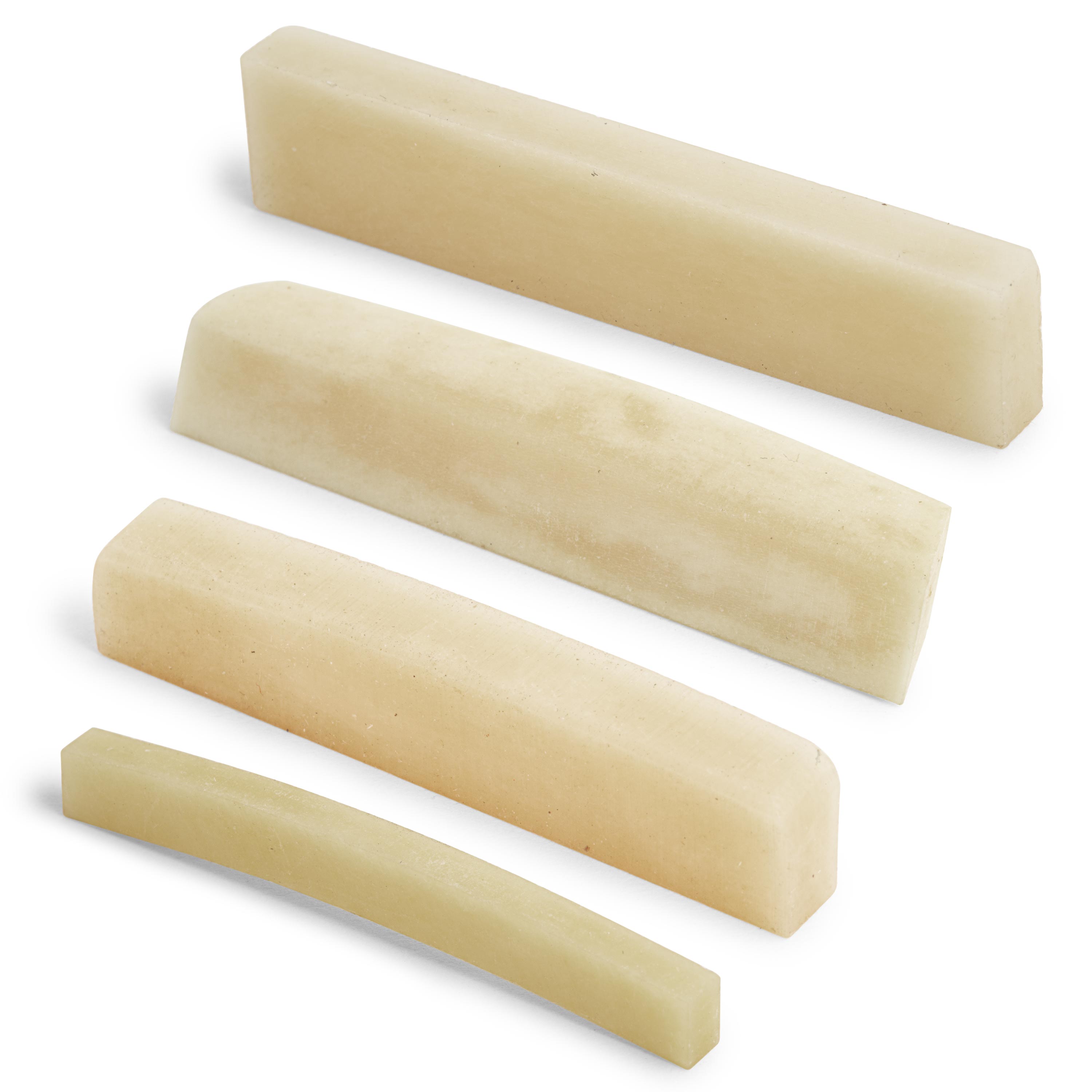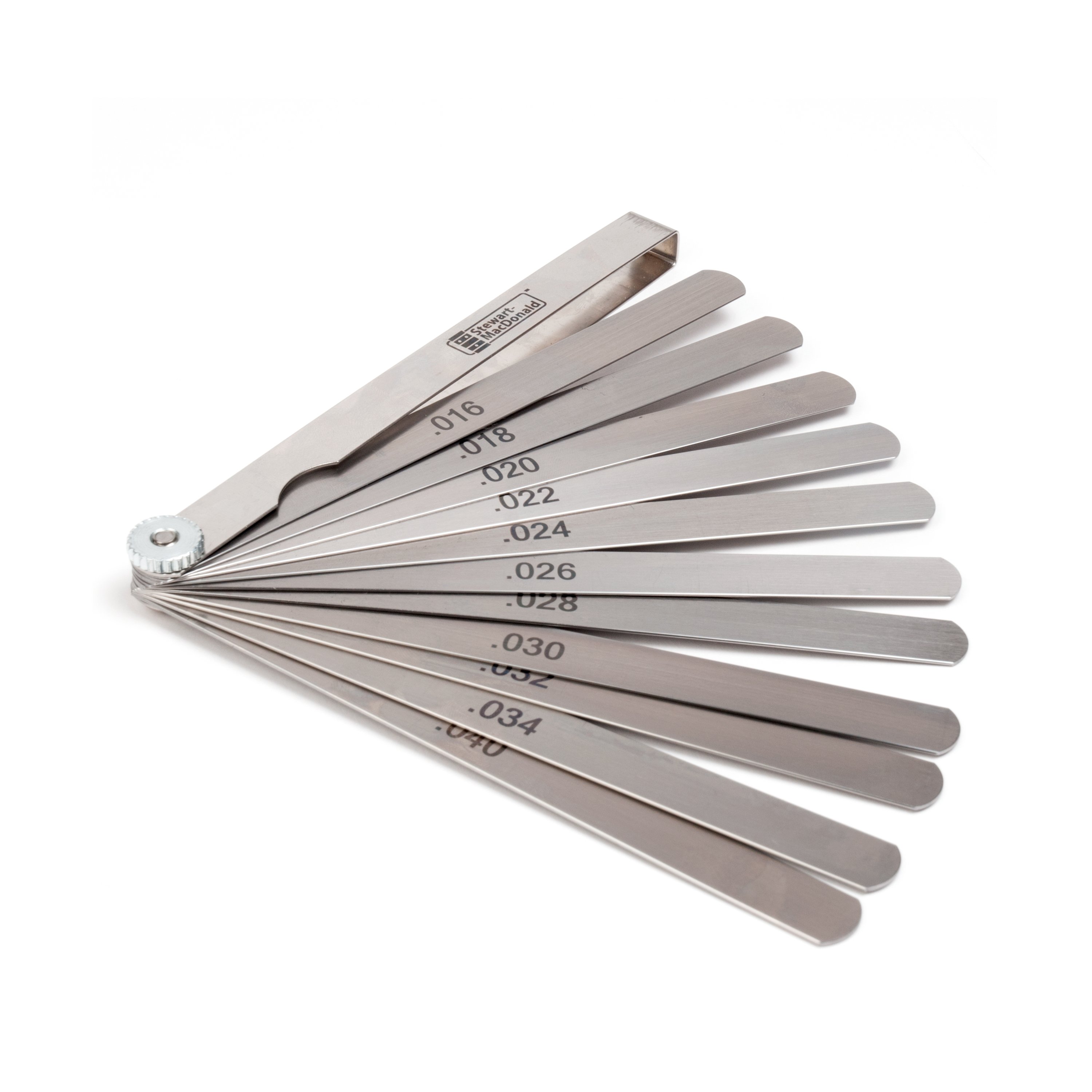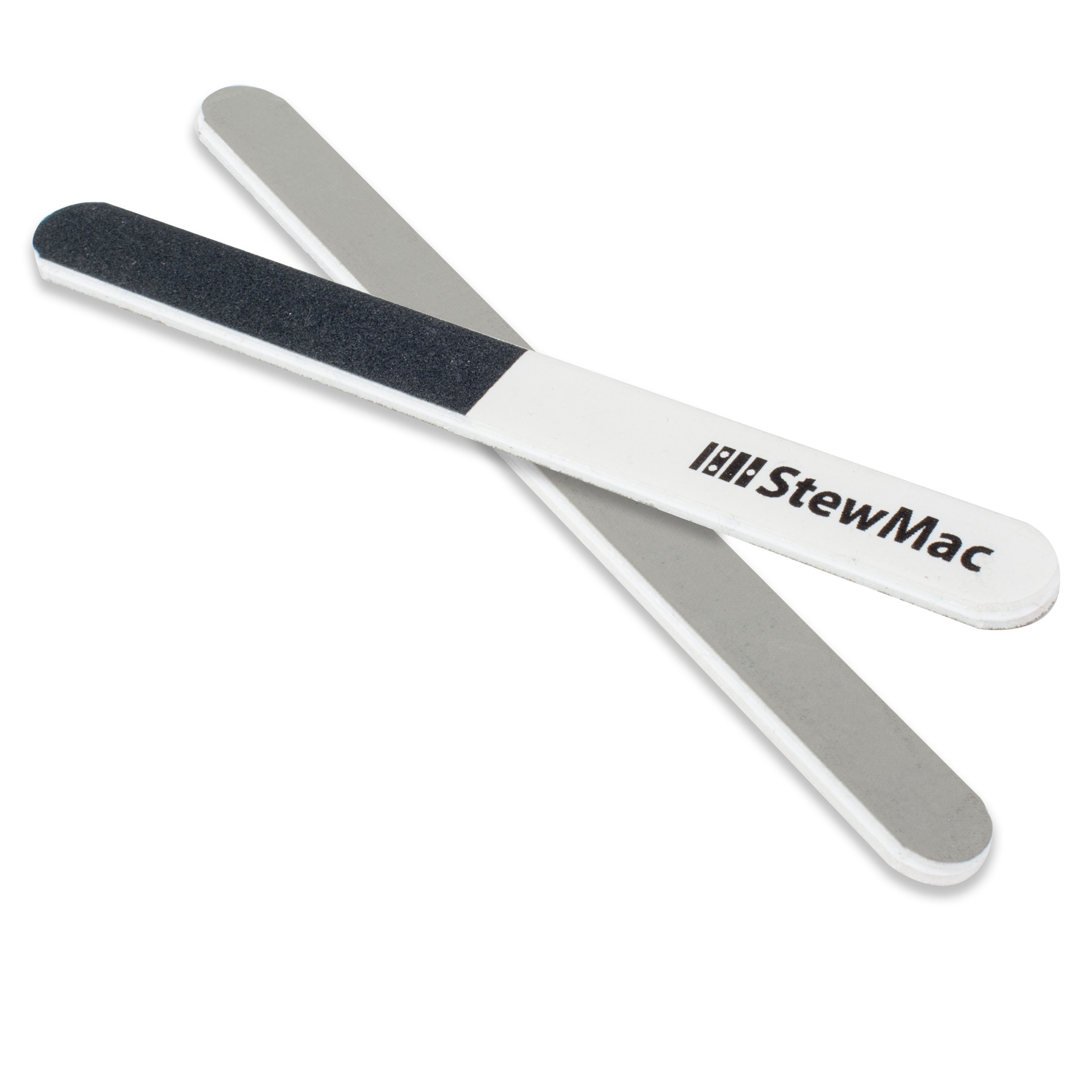How to Make a Guitar Nut from a Blank
Issue 345 April 23, 2020
Dan Erlewine and Elyse show you step-by-step how to make the perfect custom guitar nut from a blank. Elyse decided to make a guitar nut out of bone because it's light, durable and easy to work with. Elyse walks you through every detail you need to know to make your own perfect guitar nut from a blank. From removing the old nut, cleaning the nut slot, cutting and sanding, identifying and marking string spacing, proper slotting techniques, polishing the nut to get a jewel-like finish and finally installing the nut.
Video Transcription
[on-screen text reads: StewMac tools + ideas for guitarmaking. How to Make A Guitar Nut From a Blank]
Dan Erlewine: Hi, I'm Dan, and this is my apprentice, Elyse, and today we're going to have a great trade secret, and it's all about how to make a guitar nut. Why would you have to make a guitar nut on a good guitar? Well, because they wear out. If you think about it, guitar strings, especially metal ones, are like little files that have the string windings that wear aware the material every time you tune and change. I imagine if you had a time lapse camera that was in close, you could see those strings drop, and drop, and drop until they buzzed on the first fret. And there are Pre-Slotted Nuts. We sell them at StewMac that will pretty much drop into a guitar once you take the old one out, but they don't always fit every guitar, and they won't suit every action height.
So there's a lot of reasons why you want to make your own nut. We're talking about making a good nut from a Nut Blank. Nut blanks are slightly oversized, and they come in many different materials, and you can customize your nut exactly how you want it. Now, just to warn you, there are some things that can go wrong when you're making a nut. You can blow a nut when you spend a couple of hours very carefully filing the slots and getting it just where you want, that last little stroke goes too deep, and one slot drops so low, it's buzzing on a fret. At that point, you really have to start over. Over the years, I've had many apprentices in my shop, and a right of passage for them is to be able to make a good nut. Elyse has been a quick learner in making nuts. In fact, she just got her highest merit badges and about to graduate, so I think she's the right person to teach this lesson. Take it away, Elyse.
Elyse: All right, so today I'm going to be working on the Gibson Les Paul Junior. I'll be removing the current nut, which is a slightly worn bleached bone nut. What I'd like to do is use an Unbleached Bone Nut, because I really like the way the look compliments the headstock and the fingerboard. There are other materials you could work with. For example, you could use tusk, plastic, metal, but in the shop, we really love working with bone, because it's dense and durable, but light, and not too hard to work with.
Removing the old nut and cleaning out the slot
All right, my friends, let's begin by knocking out this old nut, just using a small hammer and straight edge here.
It just came right out. As you can see right here, my slot's already pretty cleaned out, which is awesome, because that saves you a lot of time and a lot of trouble. I'm just going to use a small chisel to go in and get the leftover glue and smudge that's on the side wall.
Make sure your blank is square
My next step is to make sure that my blank is exactly square. Otherwise, you can have issues down the road a little bit. I'm going to use a Machinist Square and align it right up to the corner of the square, and I can see the blank is not exactly square, and it's easy to sand off that little bit of excess with some sandpaper. That should be good.
Fit the blank into the slot
My next step now is to fit my blank into my slot. I'm using calipers to measure the nut slot and my nut at three different points [on screen text reads: Luthier's Digital Caliper - stewmac.com], and it's looking like my blank is just slightly too thick. So once again, I'll use some sandpaper. I'm making sure to put an even amount of pressure on all sides of the blank. All right, cool, so I'm right in the ballpark I need to be. So now I'm going to check and see if it fits the slot. And this is looking like a perfect fit to me. It's nice and snug, but easy enough to remove for working on.
Check the radios of the fingerboard
Next, I'm using a Radius Gauge to check the radius of the fingerboard and some Calipers to check our fret height. Now, we're going to use those two very important measurements to mark our blank. At this point, I'll use a number of different size Feeler Gauges and add up to the fret height, which for us is 47 thouandths, and then add another 10,000 onto that. That gives us a little bit of a buffer to work with, because I can always take off more height later. All right, got that marked. Now I just want to circle back and retrace my radius, and then now you see, we have that crisp line, so we know where to stand to.
Dan Erlewine: Let me add to what Elyse just showed you. She measured the fret height, and then stacked some feeler gauges on the fingerboard, equaling that height. She added another feeler gauge to raise that height, and traced the line to indicate the top of the nut. Then, she double checked to make sure she's matching the curve of the guitar's fret board with a radius gauge. This roughs in the shape of the nut. There's another tool we have at StewMac that the R and D shop has come up with. It's called the Safe Slot [on screen text reads: Safe Slot Nut Guard - stewmac.com], and it's a little padded yolk that fits right up against the nut, and you can slide feeler gauges through it. Clamp that down, get the height you want, and file until it touches the metal. It sort of protects the nut area, too. StewMac's Elliot John-Conry, a great repair man, has done a great video on how to use this. There is a link in the description below. Check it out.
Elyse: Now when you're using the belt sander, you always want to make sure you have a proper angle. I am going to sit down so I can look directly at my pencil line and my nut, so I know how much to take off, especially when it comes to rounding. Another trick Dan taught me is to keep the tips of your fingers wet, and that way the moisture can give you a nice grip on the bone [Elyse is holding the bone nut against the belt sander]. I'm happy with this because I can see the rounding came out really well and I got as close as I could to the line without going any farther. I'm now going to move on to the step of identifying my string spacing.
Identifying string spacing
I'll put my nut back in the slot, and go ahead and restrain the bass and the treble E, and this is a critical step marking your outside E's. So just to be sure I'm all good here, I've asked Dan to come over and give his opinion.
Dan Erlewine: And he is always happy to do it. That's probably a little wider towards the edges. You've got a fret and a neck, and then you've got this bevel. I like to measure in from the bevel, the edge of the bevel, not the actual width of the neck. I'm going to put it where I think it should sit on this neck. It's the 16th of an inch in from the bevel, and that's good. And this one's going to be the same, and you can't tell unless you look right down from the top. On the right track. Good luck.
Elyse: Thank you, Dan.
Dan Erlewine: Call me if you need me.
Elyse: Alrighty, so I'm going to go ahead and mark each side of the strings. To mark the rest of my string spacing, I'm using this very handy string spacing rule. If you're making a lot of nuts, this is a must-have tool. Find the point where the two outside strings line up, and then the rest of the string spacing is measured out for you. There we go. Before we start slotting, I'm just going to add a little tape for protective measure, just in case the file slips or anything like that.
Start slotting the nut
So I'm not going to start filing real deep right away. At first, I'll just make some starter slots to get us going, and you always want to position yourself as directly over the fingerboard and the nut as possible so you're able to get that straight line.
Slotting our depth
Now that we have started our slots, we're going to be moving onto slotting our depth. We're going to be using the StewMac Gauged Nut Slotting Files. These files come in different gauges that correspond to whatever gauge strings you are using. In our case, we are going to be working with light gauge strings, so we'll use the appropriate files for those measurements. Let's go ahead and get our strings back onto tension, and I'll be starting with the bass E string slot. As I file, I'm going back and forth a bit instead of just straight down. This is side filing, and it creates a nice round bottom for the strings to sit in instead of a sharp V shape.
My action is still quite high, so I know I'll eventually need to slot a bit deeper, but let's save that for later. For now, I'm going to take off the extra material from the sides of the nut. Standing over the nut, trace the shape of the headstock down to the fretboard to help give you a nice, accurate line. I'll be using a razor first, and then a pencil, so that when I go to saw off the ends, that little notch will help me get a clean cut. I'm going to be using a Nut and Saddle Vise. Ooh, that sounds like nails on a chalkboard.
As we can see right here, our ends are not even at all, and they look kind of sloppy from the hacksaw. I'm just going to use some coarse and fine StewMac files to try to file the ends more evenly. Still a little rough, but I'll get that with some standing later. Let's move on now to checking how much height we need to shave off. So you'll know when you have to take off more height. When you see that the string is completely sitting inside of that slot. That's what's going on right here, and we don't want that, but what you want to aim for is having about half the string depth sitting in your slot.
Dan Erlewine: But with the thinner unwound strings, like the G, B, and E strings, they need to sit a little deeper in the slot, or they can pop out. Close to the full diameter of those strings will sit in the slot instead of just half.
Elyse: All right, cool. We are ready to slot our final depth now.
Dan Erlewine: I want to say a little bit about back filing. Once you've gotten to the depth, then it's time to stop going deeper, and start to clean it up, you back file. Back filing gives you a controlled rounded point so that just like the shape of the nut, that's coming up on a general curve, the string follows that so it has a good deal of meat at the front edge. You can actually point it at the angle of the peg header to the tuning post, because that's where the string is going.
Elyse: Now it's time for our final test. And this action is right where I want it. That's about perfect. Now it's time to move on to rounding and polishing, our final steps.
Rounding and polishing the nut
What you're really doing here is just smoothing out those edges with a fine tooth file, making sure you have that final shaping just how you want it. I'll follow up with some sandpaper to get those scratches out. I am working from 400 to 600 to 800. This is looking good and feels super smooth. Let's polish this thing and make it shine.
I'm using the micro-mesh stick [on screen text reads: Micro-Mesh Touch Up Stick - stewmac.com], which is awesome, because it has three fine grits built into one tool. It's pretty much all you need to make this thing look like a piece of jewelry. There we have it. Now it's time for us to glue in the nut, finally. So I'm going to be using just a few droplets of original Titebond [on screen text reads: Titebond Wood Glue - stewmac.com]. [Elyse is applying small dabs of the blue to the nut slot using a toothpick] That's really all it needs. Put some string tension on. Waiting for this nut to dry with Titebond, it should typically take about a half an hour to an hour. If you're finished working on it for the day, just leave it for overnight.
The final check-up
Dan Erlewine: Giving it the final check-over, and man, Elyse did a really good job. The string spacing just the way I showed her and wanted. Nice low action, and it's polished like a jewel. Now there are some details I'm going to point out that she could practice more on in the future. She sanded a bit too much. You can really see it around the low E string slot. It looks a little more rounded than I want to see. It'll sure feel good on the hand, though. The slot depths look good on the A and E strings. They're about half as deep as the string diameter. This G string slot looks good, but the B string slot is just a little too deep, I think. And it looks like it may have been back filed at a little too steep of an angle.
You can see some scratches on the top. That's left over from sanding or filing. Those could have been sanded out before polishing, and the nut's still just a little wide for the slot. It's hard to see because of the roundness, but it's sticking out just a touch. For a comparison. Here is another Gibson style nut. This one's on an Erlewine guitar, a recent replica of the guitar I built for Blues man Albert King in the 1970s. Taking a close look here, the edges of the bone are smooth, but not to the point of looking round.
You can see the wound strings sitting halfway into their slots and the thinner unwound wound strings are sitting a little deeper. The lines on the top here aren't scratches. Those are the natural grain of the bone itself. So Elyse did a great job and she is learning fast. It takes years to become a pro at this job, but she made a beautiful nut that works great on this guitar, and it's more than satisfactory in my book. Guys, why don't you come in here? Elyse, we'd like to give you a diploma that you have graduated to the next level, and we're just so proud.
Elyse: Thank you so much, Dan.
Dan Erlewine: You're welcome. This doesn't come easy, by the way. You have to practice a lot, right?
Elyse: Yes.
Dan Erlewine: You won't get it right on the first nut you make, but practice makes perfect, and you proved it.
Elyse: Thank you, especially, Dan.
Dan Erlewine: Woo-hoo!
Speaker 3: Woo! Woo-whoop! Whoop, whoop, whoop!










